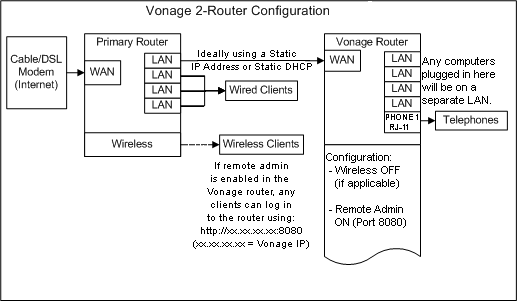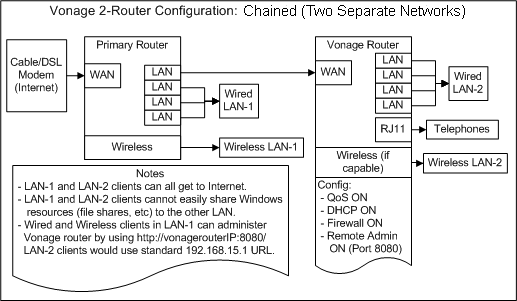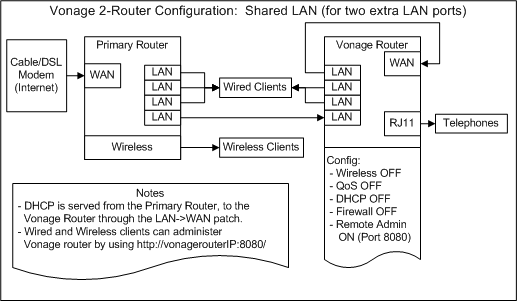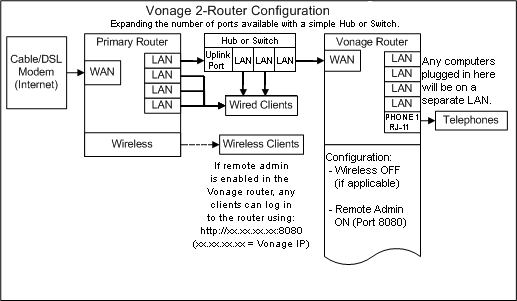What to do when you have more than one Router (a Vonage router plus at least one more).
There are three variants to configuring two routers. Which one is right
for you depends on whether you want to be able to share network
resources between computers, and how much load you want to put on your
various equipment. As a rule, unless your existing router is very old,
I don't recommend putting Vonage devices out front. In my experience,
and that of others I've seen on the forums, Vonage devices seem to work
better when placed behind a more effective router.
I'll list out the three configurations I have worked up as baselines,
and you can work out what seems to be the ideal for you. From there,
you can modify these configurations to suit your needs, of course.
Option 1: Single LAN
What I call the "ideal" configuration, with one router doing all the
"work", but limited to three Ethernet ports, plus wireless if
applicable.

Advantages:
1. One router "running the show", with one network.
2. Vonage router does not have any responsibilities but serving up
Vonage, which generally makes it work better as a Vonage device.
Disadvantages:
1. You only have three wired Ethernet ports remaining on your primary
network. You can purchase a cheap switch or hub to add more Ethernet
ports to the primary network, though.
Option 2: Chained LAN
The "Chained LAN" configuration actually creates two separate
networks. While both networks have access to the Internet, you cannot
easily share network resources between the two networks.

Notes:
1. The Vonage router will generally have top priority in the primary
router's QoS, so selecting devices that won't take up a lot of
bandwidth, but want high priority on the Internet, is a MUST (ie. the
Vonage router would be a good place to put gaming consoles, and web
surfing workstations, but a POOR place to put machines that do
P2P/BitTorrent or frequently do large downloads or uploads.
2. The QoS on the Vonage router should be turned off. Your primary
router will be handling the QoS duties, and the Vonage router will see
the available bandwidth of your network, not of your Internet
connection, so it will not work well. Having it on just wastes time
evaluating all the packets.
3. The SPI firewall on the primary router should be turned on, but the
firewall on the Vonage router should be off. One firewall is
sufficient, and having the Vonage's firewall on simply adds overhead to
no good purpose. The exception to this is if you allow public wireless
access to your primary router - in this case you should turn off the
SPI firewall on your primary router and turn ON the Vonage router's
firewall, as you will have untrusted clients on your primary LAN.
Advantages:
1. More Ethernet ports available than option 1.
2. Extra layer of security if you allow public access to wireless or need to run an unsecured wireless LAN.
Disadvantages:
1. Two separate networks that cannot easily share resources between them.
2. Any routers behind the second router need to go through two NAT layers, which is pretty inefficient.
Option 3: Shared LAN
The "Shared LAN" configuration puts both sets of LAN ports on
the same logical LAN, DHCP served to all by the primary router.

The network part of me is still not a fan of the #3 configuration, but I tested it out for
several months, and it DOES work. The only real advantage it
offers is the addition of two new LAN ports, and the ability to have
sets of LAN ports apart from each other. Well, let's face it. The only real advantage is that it saves you money buying a switch, or allows you to use an access point AND all the Ethernet ports (except one) on a secondary router without acutally using its router function.
I will say, however, that access to the Configuration page of my
WRTP54G has been intermittent under this configuration. The Vonage line
does work 100%, and VPN connections on my laptop, which is plugged into
an Ethernet port on the Vonage router, work perfectly for days at a
time. But the config page on the Vonage router does concern me.
Advantages:
1. One LAN, with the most ports available. The two routers can be
placed distantly from each other with a long patch cable, so you could
have one LAN with wires in two distant rooms.
Disadvantages:
1. Risk. You essentially have a circular route on your network, though it's unlikely that it would ever be accessed.
2. Router configuration page inaccessible. I have my Vonage router set
up to be accessed remotely, and I can ping it, and tracert shows a
direct path to it, but I cannot access it on port 8080. This is an
intermittent, but worrying, issue. I don't know if Firmware updates
would be loaded to the Vonage router under these circumstances, for
example, and this could be a symptom of a larger routing issue, though
nothing else appears broken.
NOTE: You can keep a single subnet and add ports by simply adding a cheap hub or switch, and in my opinion you'd be better off doing so. The Vonage router can be plugged either directly into the main router, or into the Switch as shown below, depending on where you need the Ethernet ports to be. It really makes no difference.

You could also put the Vonage router out "front", of course, in any of these configurations.
About This Page



